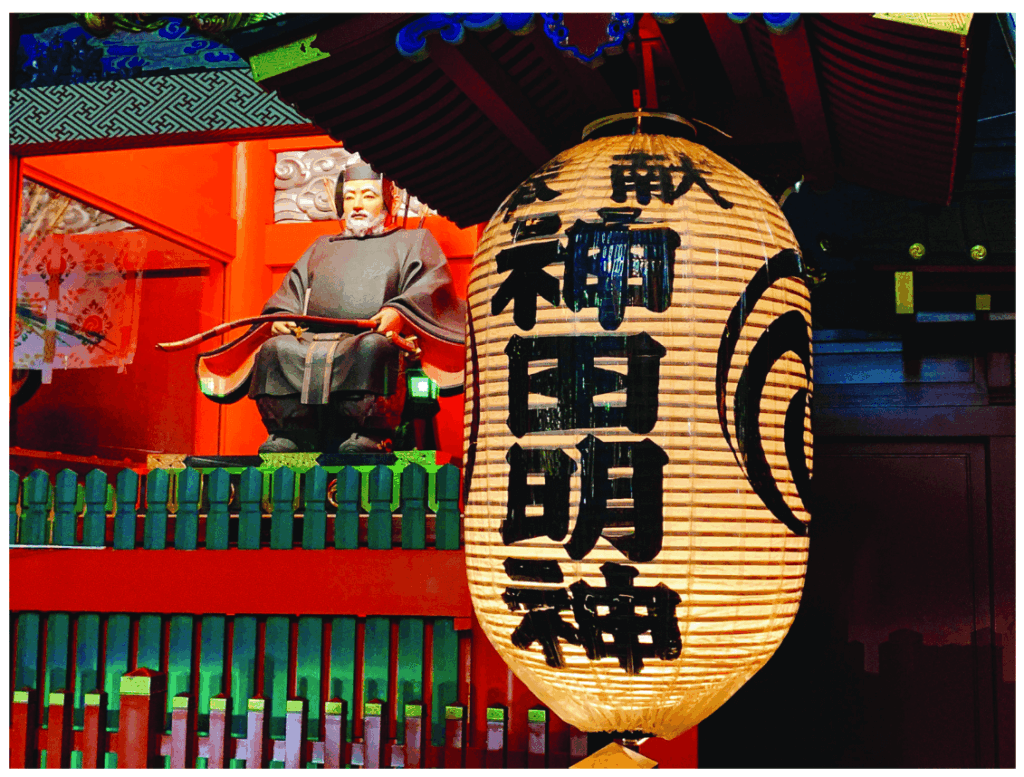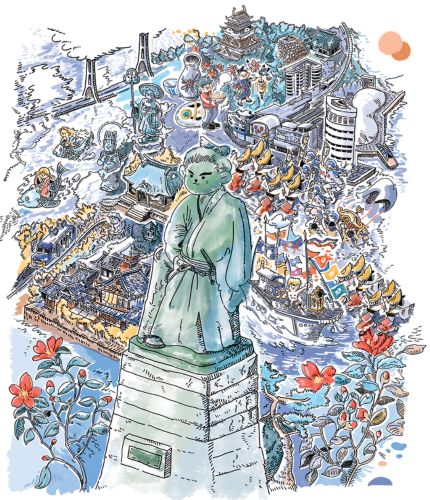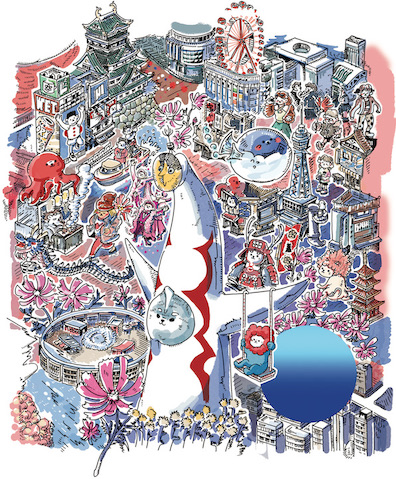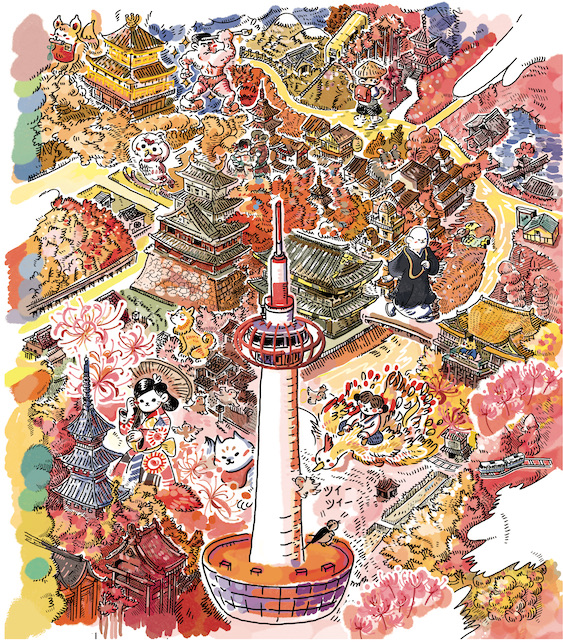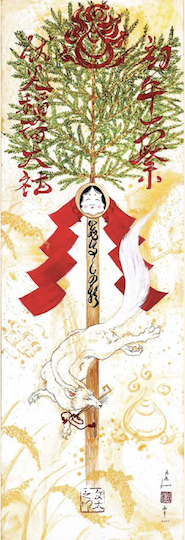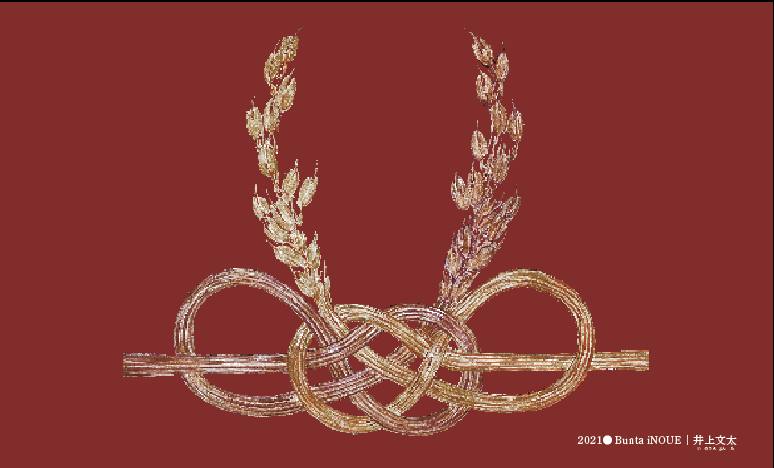-
[Cover story – January 2026 Issue]
The New Year’s Bell Opens the Gate of Heaven
“世明け”を告げる鐘In the deep silence of midnight as the New Year arrives, the solemn peal of Joya-no-Kane—the New Year’s Bell— resonates through the darkness. Its heavy vibrations, said to sweep away worldly desires and cast off the old, carry the power to open a new gate. What appears on this month’s cover is the very moment that the gate of the new world dawn swings open.
新しい年を迎える深夜、深い静寂の中に除夜の鐘が響きわたります。古いものを払い、煩悩を祓うとされるその重い振動は、やがて 新たな世の夜明けの門 をひらく力となります。今月の表紙に描かれているのは、まさにその 「新しい世界の門」が開く刹那 なのです。
From within the bell—opening like a passage into the depths of the cosmos— the new zodiac sign, the Horse, descends together with shimmering stars. As tradition tells, the celestial steed touches the earth with its forelegs first— a single step marking a dawn moment when auspicious light begins to seep into the world. And this heavenly horse is none other than the very horse of the Soma clan, a lineage that has lived alongside horses for more than a thousand years.
宇宙の深淵へと続く鐘の中から、瞬く星々とともに新しい干支・午が降りてきます。伝承の通り、天馬は前足から地を踏みしめます。その一歩は、よき兆しが地上へ染みわたる黎明の一瞬です。そしてその天馬は、千年以上にわたり馬と共に生きてきた相馬氏の馬そのものです。

Rooted in Fukushima and known as descendants of Taira no Masakado, the Soma clan has lived every battle, every prayer, and every moment of daily life side by side with their horses. The spirit of Soma Nomaoi—an ancient equestrian tradition found nowhere else in the world and now designated as a National Important Intangible Folk Cultural Property— is the very pride of Soma itself.
福島県に根を張り、平将門の後裔として知られる相馬氏は、戦いも祈りも暮らしも、常に馬と共にありました。世界に類を見ない古式馬事、相馬野馬追(のまおい)の精神は、国の重要無形民俗文化財にも指定された、相馬の誇りそのものです。
On the armor of the samurai riding the celestial steed shines the Kuyō crest, borne for generations by the Soma clan who inherit the lineage of Masakado. It glows in harmony with the stars of the universe. On the samurai’s robe, the serpent of the previous year’s zodiac is depicted, quietly embodying the continuity of time, the cycle of life, and the layers of history that flow beneath the present moment.
天馬に跨る侍の甲冑には、将門の流れを継ぐ相馬氏が代々掲げてきた九曜紋が輝き、宇宙の星々と共鳴しています。侍の衣には、前年の干支・巳が描かれ、時間の連続性や命のめぐり、歴史の重なりが静かに息づいています。
Fukushima Prefecture, homeland of the Soma clan, is the third largest in Japan and is composed of three distinct regions: Hamadori, Nakadori, and Aizu. Hamadori, shaped by the sea and wind; Nakadori, a fertile heartland; and Aizu, a region embraced by mountains— each has nurtured its own history and culture over the centuries.
相馬氏ゆかりの地である福島県は、日本で三番目に広く、「浜通り」「中通り」「会津」から成る県です。海と風の「浜通り」、実りの大地「中通り」、山々に守られた「会津」——それぞれが異なる歴史と文化を育んできました。
Among these regions, Hamadori—where the city of Soma lies— bore deep wounds from the 2011 Great East Japan Earthquake, the tsunami, and the nuclear disaster that followed. The year 2026 marks fifteen years since that day. For this region, which has walked through a long stretch of darkness, the “dark interior” of the bell depicted on this cover stands as a symbol of the shadows of its past.
その中で相馬市が位置する浜通りは、2011年の東日本大震災と津波、そして原発事故という深い傷を負いました。2026年は、あの日から15年の節目。長い暗がりを歩んできたこの地域にとって、この表紙に描かれた鐘の“暗き内側”は、過去の影を象徴しています。
Yet—this darkness is quietly coming to an end. In the new Year of the Horse, starlight will once again pour down upon the land, and a renewed radiance will begin to fill the year ahead. And this horse will race across the whole of Japan, its gallop tracing a lineage that reaches back a thousand years, ultimately leading to Taira no Masakado,
the revered ancestor of the Soma clan.けれども——その暗がりは、静かに終わりを告げつつあります。新しい午の年は、星の輝きが再び大地へと降りそそぎ、再生の光が満ちていく一年となるでしょう。そして、その馬は、日本全土へと駆け抜けていきます。その姿は、千年の系譜を遡り、相馬氏の祖・平将門へと結ばれていきます。
Kanda Myōjin in Tokyo, where Masakado is enshrined, will celebrate the 1,300th anniversary of its founding in 2030, four years from now. The prayers of Masakado—who once stood for the people of the eastern provinces and longed for a new and better age— continue to breathe across a millennium.
将門を祀る東京都の神田明神は、4年後の令和十二年(2030年)、創建一三〇〇年の節目を迎えます。かつて東国の民を思い、新しき世を願った将門の祈りは、千年の時を越えて息づいています。

A new era is quietly beginning— a time in which the stories carried by this lineage will once again reclaim their light. May the year 2026 become a radiant Year of the Horse, galloping forward with hope, courage, and renewed brightness.
その系譜に連なる物語が、再び光を取り戻す時代が、いま静かに始まりつつあります。2026年が、希望と勇気と光へと駆け抜ける美しい午の年となりますように。
This article is from the January 2026 issue of Hiragana Times.
この記事は、月刊誌『ひらがなタイムズ』2026年1月号より掲載しています。
-
[Cover story – December 2025 Issue]
Discovering Shikoku through Flavor, Flowers, and Faith
味・花・祈りで巡る四国の旅This month’s cover is themed around the island of Shikoku. Seen through the vibrant lens of Hong Kong-based illustrator Angryangry, the illustration offers a whimsical yet deeply respectful view of this often-overlooked cultural gem.
今月の表紙は、四国がテーマです。香港在住のイラストレーター・Angryangryの鮮やかな視点を通して、見過ごされがちなこの文化の宝庫を、ユーモラスかつ敬意をもって描き出しています。
From the statue of Ryoma Sakamoto in Kochi, famous for its katsuo (bonito), to the castles of Marugame and Matsuyama that echo with samurai heritage, the map is a vibrant celebration of Shikoku’s rich layers of history and flavor.
鰹で有名な高知の坂本龍馬像から、武家文化を今に伝える丸亀城や松山城まで、歴史と味わいが折り重なる四国の魅力が、賑やかに描かれています。
The featured theme this month, umami, is deeply intertwined with the natural and cultural landscape of Shikoku. Dashi made from dried bonito flakes is not merely a soup base—it serves as a vital “pulse” that guides the entire flow of Japanese cuisine. Kochi, in particular, has long been at the heart of this tradition.
特集テーマである「旨味」は、こうした四国の風土と深く結びついています。鰹節を用いた出汁は、単なるスープの素ではなく、日本料理を導く“脈”のような存在。とりわけ高知は、その伝統の中核を担ってきました。
The culinary journey through Shikoku continues into Kagawa. Known for its Sanuki udon, this region offers a bowl where clear dashi—made from dried sardines (iriko), kelp, and bonito flakes—beautifully intertwines with firm, chewy noodles. Simple yet profoundly flavorful, each serving of udon reflects a perfect harmony of local ingredients and artisanal skill. In every bowl, the essence of Shikoku’s umami culture is richly condensed.
さらに、四国の味の旅は香川へと続きます。讃岐うどんで知られるこの地では、いりこや昆布、鰹節などから取った澄んだ出汁が、コシのある麺と絡み合い、素朴ながらも奥深い味わいを生み出します。土地の恵みと職人技が結晶した一杯のうどんには、四国の旨味文化が凝縮されています。
In addition to food, the illustration highlights Shikoku’s spiritual depth: the famed 88-temple pilgrimage route, or henro, winds through the mountains, while Awa Odori dancers evoke centuries-old celebration in Tokushima.
食の魅力に加え、四国の精神的な深みも表現されています。山間を巡る八十八ヶ所巡礼の道、そして徳島に息づく阿波踊りの熱気が、土地の祈りと祝祭を象徴します。
Seasonal flora, like the camellia sasanqua featured in the “Ibuki” section, blossom across the island’s landscape, further enriching its cultural and natural profile.
「息吹」コーナーで紹介されるサザンカをはじめ、四国各地には季節の花が咲き誇り、文化と自然が調和した風景を彩ります。
This article is from the December 2025 issue of Hiragana Times.
この記事は、月刊誌『ひらがなタイムズ』2025年12月号より掲載しています。
-
The Spirit of Summer in Hiroshima: Peace, Memory, and the Bloom of Morning Glories
夏のいぶき、広島に宿る—— 平和と記憶、そして朝顔の花- Hiragana Times
- Aug 06, 2025
[Cover story – August 2025 Issue]
The Spirit of Summer in Hiroshima : Peace, Memory, and the Bloom of Morning Glories
夏のいぶき、広島に宿る—— 平和と記憶、そして朝顔の花This month’s cover takes us to Hiroshima, a city that carries the weight of history and the hope for peace. At the center of the artwork is a pure white dove—symbol of peace—spreading its wings over a tranquil river, as if to gently protect the city below.
今月号のカバーが描き出すのは、深い歴史と平和への願いを抱く広島の風景。作品の中央には、翼を広げる白い鳩——平和の象徴——が、静かな川の上を舞い、街を優しく包み込むように浮かんでいます。
This year marks the 80th anniversary of the end of World War II. On the morning of August 6, 1945, at 8:15 a.m., when the atomic bomb was dropped on Hiroshima, morning glories must have quietly opened their blooms—just as they did on any other morning—only to be swept away in an instant by the blast.
今年は終戦から80年。1945年8月6日午前8時15分、あの原爆が投下されたその朝にも、朝顔はきっと、いつもの朝と同じように静かに花を広げ、そして儚く、爆風に吹き飛ばされたことでしょう。
And yet today, those same morning glories bloom again, vivid and full of life—having endured across time, they now live on as symbols of life pulsing through the summers of Japan.
その朝顔は、いま、色鮮やかに――時を超えて生き抜き、今も日本列島の夏に息づく命として、いきいきと咲いています。
Also featured in this issue’s Ibuki section, this humble summer flower carries with it both a quiet memory and the strength to look forward.
今号の「いぶき」コーナーでも特集しているこの夏の花が、静かな記憶と、前を向く強さを同時に伝えてくれます。
Landmarks such as the Atomic Bomb Dome, the Peace Memorial Park, and Hiroshima Castle are thoughtfully illustrated, reminding us of the city’s journey from devastation to rebirth. In the bay, a vermilion torii floats on the sea—an iconic image of Itsukushima Shrine, one of Japan’s three most scenic spots.
原爆ドーム、平和記念公園、広島城など、街の歴史を物語る建築物が、丁寧に描き込まれています。広島湾には、日本三景のひとつ、厳島神社の朱塗りの鳥居が海に浮かび、この地の美と信仰を象徴しています。
On the back cover, we find a scene from Bugaku, a ceremonial court dance passed down through centuries at Itsukushima Shrine. Originating in ancient India and traveling through China and Korea to Japan, this art form now survives only here. Still today, traditional pieces like Ranryōō and Banzeiraku are performed on the shrine’s stage, echoing the pulse of time.
裏表紙には、厳島神社で今も奉納される舞楽の様子が描かれています。インドを発祥とし、中国、朝鮮半島を経て伝わったこの芸能は、現在、世界で唯一この神社にのみ伝承されています。蘭陵王や万歳楽など、千年を超えて受け継がれる舞と音が、今も神前に響きます。
Through this vibrant and poetic artwork, Hiroshima is not only a place of memory, but one of living culture and hope. May the breath of peace continue to flow through each passing summer.
この色彩豊かで詩的な作品を通じて、広島は、記憶の地であると同時に、今も生きる文化と希望の場所であることを語りかけてきます。平和のいぶきが、これからも夏ごとにこの街に流れ続けますように。
This article is from the August 2025 issue of Hiragana Times.
この記事は、月刊誌『ひらがなタイムズ』2025年8月号より掲載しています。
-
[Cover story – November 2025 Issue]
Autumn’s Breath in Tokyo — A Map of Chrysanthemums, Towers, and Memory
東京に咲く秋のいぶき —— 菊と塔と記憶の地図A cityscape bathed in autumn hues stretches across the cover of our November issue. Surrounding the iconic Tokyo Tower at the center, a nostalgic and lively depiction of the city unfolds — one that traces memories from the Edo period to the present day.
11月号の表紙には、秋色に染まる東京の街が広がります。中心にそびえる東京タワーのまわりに、江戸から現代へと続く都市の記憶が、どこか懐かしく、にぎやかに描かれています。
This red-and-white iron tower was completed in 1958 as a symbol of Japan’s postwar recovery. It embodied the hopes of the high-growth era, and even now, it remains a “beacon of the heart” for many.
この赤白の鉄塔は、戦後日本の復興の象徴として1958年に誕生しました。高度経済成長期の希望を体現しながら、今も多くの人にとって「心の灯台」のような存在です。
At its base, chrysanthemums — the flowers of autumn — bloom in full glory. In Tokyo, the season is brightened by unique chrysanthemum events like the Meiji Shrine exhibition, the Bunkyo Festival at Yushima Tenjin, and the “Chrysanthemum Skytree” at Kameido Tenjin.
足元には、秋の花・菊が豊かに咲き誇っています。
明治神宮の菊花展、湯島天神の文京菊まつり、亀戸天神の「菊のスカイツリー」など、東京各地で個性豊かな菊の名所が秋を彩ります。The chrysanthemum has long been used as the imperial crest of Japan. This city is also home to the Emperor, who resides in the Imperial Palace where official ceremonies still take place. The Emperor’s presence at the heart of Tokyo reminds us that this is not just the political capital, but also the symbolic center of the nation. In this light, the chrysanthemum is more than just an autumn bloom — it quietly illuminates the cultural core of Japan.
また、菊は古くから天皇家の紋章としても用いられてきました。この街には、今も天皇が暮らし、公的儀式が執り行われる皇居が存在しています。都市の中心に天皇がいるという事実は、東京が単なる首都ではなく、「象徴の都」であることを物語っています。そうした文脈において、菊は単なる秋の花ではなく、日本文化の核心を静かに照らす特別な存在なのです。
This month’s cover was once again illustrated by Hong Kong–based artist Angryangry. At the end of November, they will hold their first solo exhibition outside of their home country, titled Outsiders’ Outlines, in Asakusabashi, Tokyo. New works inspired by their keen observations of Japanese towns and people will also be on display.
今月も表紙を手がけたのは、香港在住のイラストレーター・Angryangry。 11月末には、東京・浅草橋にて初の海外個展「Outsiders’ Outlines」が開催されます。 日本の街や人々を観察して描いた、新作の数々も披露される予定です。
This article is from the November 2025 issue of Hiragana Times.
この記事は、月刊誌『ひらがなタイムズ』2025年11月号より掲載しています。
-
The Autumn Light Rises Again — Memories of Osaka Expo and Cosmos Flowers
- Hiragana Times
- Oct 08, 2025
[Cover story – October 2025 Issue]
The Autumn Light Rises Again — Memories of Osaka Expo and Cosmos Flowers
秋の光、再び空へ――大阪万博とコスモスの記憶Featured on this month’s cover is Osaka, the city of the World Expo. Towering in the center is the “Tower of the Sun,” a symbolic structure built for the 1970 Osaka Expo — the first World Exposition held in Japan.
今号のカバーに描かれているのは、万博の街・大阪。中央にそびえるのは、1970年に開催された日本初の万国博覧会「大阪万博」のシンボルとして建てられた「太陽の塔」です。
Created by artist Taro Okamoto, the tower embodied the Expo’s theme, “Progress and Harmony for Mankind.” Its three symbolic faces — past, present, and future — left a lasting impact. Even after 50 years, it still rises like a symbol of Earth’s raw energy.
この塔は、芸術家・岡本太郎が「人類の進歩と調和」をテーマに制作。太古・現代・未来の三つの顔をもつその斬新なデザインは、人々に強烈な印象を与えました。50年以上の時を経た今も、大地のエネルギーの象徴として空を見上げています。
In 2025, Osaka once again plays host to the World Expo. As the event approaches its final day on October 13, the “Expo Commemorative Park” beneath the tower comes alive with a vibrant display of seasonal flowers.
今年2025年、大阪では再び万博が開催されています。その最終日となる10月13日を前に、塔のふもとに広がる「万博記念公園」では、秋を彩る花々が見ごろを迎えています。
Among them, the cosmos — this issue’s featured “Ibuki” flower — takes center stage.
In the “Hill of Flowers” area, some 140,000 cosmos bloom each year from early to late October, their pink, white, and red petals dancing gently in the autumn breeze.なかでも「いぶき」コーナーで特集している花、コスモスは、この季節の主役。園内の「花の丘」には、例年14万本ものコスモスが咲き誇り、ピンク、白、赤の花が風に揺れて、秋空をやさしく彩ります。
Surrounding the scene are Osaka’s beloved landmarks — Tsutenkaku Tower, Dotonbori, Osaka Castle — all adding rich layers of Kansai’s bold and colorful culture.
周囲には、通天閣や道頓堀、大阪城など、個性あふれる大阪の名所も数多く描かれ、ユニークで力強い関西の文化がにじみ出ています。
The Tower of the Sun, once built to dream of the future, continues to shine upon those who look skyward. At its base, the cosmos flowers whisper quietly of life’s resilient breath — gentle yet enduring.
かつて未来を夢見て建てられた太陽の塔は、今も空を見上げる私たちを照らし続けています。 そのふもとに咲くコスモスの花々は、小さくも確かな、命のいぶきを伝えてくれます。
This article is from the October 2025 issue of Hiragana Times.
この記事は、月刊誌『ひらがなタイムズ』2025年10月号より掲載しています。
-
The Breath of Autumn Illuminates Kyoto — A Tower of Light and the Memory of Red Spider Lilies
- Hiragana Times
- Sep 29, 2025
[Cover Story – September 2025 Issue]
The Breath of Autumn Illuminates Kyoto — A Tower of Light and the Memory of Red Spider Lilies
秋のいぶき、京都に灯る——塔の光と彼岸花の記憶This month’s cover captures a quiet autumnal view of Kyoto, wrapped in warm, seasonal hues.
今月号のカバーは、秋色に染まる京都の街並みを描いた一枚です。
At the center of the scene stands Kyoto Tower, located at the city’s gateway near Kyoto Station. Resembling a tall candle, the tower was inspired by the idea of “a light without fire” in a city filled with wooden architecture.
画面中央にそびえるのは、京都の玄関口・京都駅前に建つ「京都タワー」。まるで一本の大きな蝋燭のようなこの塔は、伝統的な木造建築が多い京都の街に「火を使わない灯り」を灯す、という発想から生まれました。
The tower was completed in 1964—the year of the Tokyo Olympics, a symbolic time when Japan was reemerging on the world stage after World War II. In Kyoto, a city with over a thousand years of history, the tower quietly took its place as a beacon pointing toward the future.
建設されたのは1964年――東京オリンピックの年であり、日本が戦後から立ち上がり、世界に向けて再出発した象徴的な年でもあります。千年の都・京都に立てられたこの塔は、「未来へのともしび」として、人々の希望を静かに照らしてきました。
In the depicted landscape, Kyoto’s iconic temples and shrines—such as Kiyomizu-dera, Kinkaku-ji, Nijō Castle, and Fushimi Inari—are nestled among trees adorned in brilliant autumn leaves, deepening the richness of the scene.
描かれた風景には、紅葉に染まる京都の街並みに、清水寺や金閣寺、二条城、伏見稲荷など、数多くの歴史的建築が点在し、秋の彩りとともに風景に深みを添えています。
Adding a vivid accent of red to the scene are the red spider lilies, or higanbana. Blooming around the autumn equinox, these flowers are also featured in this issue’s Ibuki section, gently evoking memories of ancestors and quiet moments of remembrance.
そこに、鮮やかな赤のアクセントとして咲くのが「彼岸花」。今号の「いぶき」コーナーでも特集しているこの花は、ちょうど秋のお彼岸の頃に咲き、故人を偲び、静かに手を合わせる心を呼び起こします。
In autumnal Kyoto, layers of time overlap, and memory and prayer pass gently through the air.
秋の京都には、時間の層が折り重なり、記憶と祈りがそっと行き交います。
This article is from the September 2025 issue of Hiragana Times.
この記事は、月刊誌『ひらがなタイムズ』2025年9月号より掲載しています。
-
The Messenger of the Blue Ocean | 蒼き海の使者
[Cover Story – March 2025 Issue]
The cover of this month’s issue, which will be available in bookstores during the Pisces season (February 19 to March 20), features “The Messenger of the Blue Ocean.” painted by Bunta Inoue.
魚座の期間(2月19日〜3月20日)に書店に並ぶ今月号の表紙は、井上文太氏による青木海の使者です。The whale’s voice, known as the “whale song,” is said to be the farthest-reaching sound made by any animal on Earth.
ホエールソングと呼ばれるクジラの声は、地球上で最も遠くまで届く動物の声として知られています。Using extremely low-frequency sound waves, whales are believed to communicate with each other across thousands of kilometers – roughly the distance from Japan to Hawaii.
極低周波音を使い、数千きろ、つまり日本からハワイほどの距離を隔てた個体同士が交信していると考えられています。Considering that vast distance, it would not be surprising if whales had a universal language shared across the world.
その距離を思えば、クジラが世界(地球)共通の言語を持っていたとしても不思議ではありません。However, whale calls are not uniform. According to research, their sounds vary by region, showing differences similar to “dialects.”
しかし、クジラの鳴き声は一様ではありません。研究によると、地域ごとに異なり、まるで「方言」のような違いがあることが確認されています。Imagining whales exchanging messages through song in the mysterious depths of the ocean is truly fascinating.
私たちが知ることのない深海の世界では、クジラたちが歌でメッセージを交わし合っていることを想像する審美的です。This month’s issue introduces Esperanto, a language created based on the idea that a shared language could help build a peaceful society. It also explores the historical encounter between English – now the de facto global language – and the Japanese people.
今月号では、「共通の言語を持つことで、平和な社会を築けるのではないか」という理念から生まれたエスペラント語の紹介をはじめ、事実上世界共通語となった英語と日本語の歴史的な出会いについても触れています。A universal language, while existing, still allows for difference to be respected. Perhaps such an ideal, harmonious society already exists beneath the vast ocean, beyond our sight.
共通の言語を持ちながら、それぞれの違いを尊重し合う。そんな理想の調和社会が、私たちの目には見えない大海原の下には既に存在しているのかもしれません。 -
Fushimi Inari Taisha Hatsuma Taisai
- Hiragana Times
- Jan 22, 2025
Fushimi Inari Taisha Hatsuma Taisai | 伏見稲荷大社初午大祭
[Cover Story – February 2025 Issue]
The cover of this month’s issue features a painting by Bunta Inoue, which was dedicated to the 2024 Hatsuma Taisai at Fushimi Inari Taisha in Kyoto.
今月号の表紙は、井上文太氏が2024年の京都・伏見稲荷大社初午祭に奉納した絵画です。The deity of Inari is known as the guardian of agriculture and commerce, and the key to the rice granary, held in the mouth of the deity’s messenger, the fox, is regarded as a symbol of protecting rice, the fundamental source of life for people.
稲荷神は農業や商業の守護神として知られ、その神使である狐がくわえている米蔵の鍵は、人々の命の根源である米を守る象徴とされています。The main subject of the painting, the “Shirushi no Sugi” (Symbolic Cedar), is cherished as a good luck charm.
絵の主題である「しるし(験)の杉」は、縁起物として親しまれています。Its origins are believed to lie in the Kumano Pilgrimage, which was widely practiced from the Heian to Kamakura periods.
その起源は、平安時代から鎌倉時代にかけて広く行われた熊野詣にあるとされています。The Kumano Kodo is famous as a network of pilgrimage routes that span the mountainous regions of the Kii Peninsula.
熊野古道は紀伊半島の山岳地帯に広がる巡礼路として有名です。It might be called the Japanese version of the Camino de Santiago.
日本のカミーノ・デ・サンティアゴと言えるかもしれません。The people of Kyoto would visit Fushimi Inari Taisha on their way back from the Kumano Pilgrimage and receive a “Shirushi no Sugi” as a token of their pilgrimage’s fulfillment and as a symbol of prayers for the prosperity of their families and communities.
京都の人々は熊野詣の帰路に伏見稲荷大社を訪れ、巡礼成就の証として、そして家族や地域の繁栄を祈願したしるしとして「しるしの杉」を受け取っていました。The Hatsuma Taisai is held on the first “Day of the Horse” (in a 12-day cycle) of the new year, and its key ceremonies take place during the “Hour of the Horse” (11:00 a.m. to 1:00 p.m.).
初午祭は、新年最初の「午の日」(12日周期)に行われ、重要な儀式は「午の刻」(午前11時~午後1時)にとり行われます。In traditional Japanese cosmology, “Horse” represents summer in the seasons, south in direction, and the time when the sun is at its highest point.
「午」は四季では夏、方角では南、太陽が最も高い位置にある時を表します。Originally, the festival’s purpose was to pray for abundant crops in the coming year, timed to this specific day and hour.
この日のこの時間に合わせ、その年の五穀豊穣を祈願するのが初午祭の本来の目的でした。Today, it has become an important event not only for agriculture but also for praying for business prosperity.
現在では、農業だけでなく商売繁盛も祈願する重要な行事となっています。 -
Japan’s Power of Storytelling
- Hiragana Times
- Dec 19, 2024
Japan’s Power of Storytelling | 日本の物語力
[Cover Story – January 2025 Issue]
In the history of the world, “books” have primarily been works such as “大説 (great opinions/views)” that record the doctrines of politicians and philosophers. In contrast, in Japan, 小説 (personal opinions/views), which reflect individual thoughts or creative stories written freely, have been widely enjoyed by the general public since ancient times.
世界の歴史においては、「書物」と言えば政治家や思想家の教義を記した「大説」が主流です。対して、日本では古くから、個人が自分の思いや創作物語を自由に書く「小説」が、庶民に広く親しまれてきました。The poetry anthology Man’yōshū, whose compilation began in the late 7th century, includes songs not only from emperors and nobles but also from farmers and soldiers without discrimination. In the early 11th century, the Tale of Genji, regarded as the world’s oldest full-length novel, was born.
7 世紀後半に編纂が始まった歌集『万集 』には 、天皇や貴族だけでなく、農民や兵士の歌も分け隔てなく収録されています。そして、11世紀初頭には世界最古の長編小説とされる『源氏物語』が誕生しました。During the Edo period, a genre called “Edo popular tales” developed, catering to the common people. Among these, Tōkaidōchū Hizakurige (Jippensha Ikku, 1802‒1809), classified as a “comical book,” gained popularity, and it is said that Edo townspeople laughed out loud while enjoying it.
江戸時代には、「江戸娯楽物語」と呼ばれる庶民向けのジャンルが発展します。その中でも『東海道中膝栗毛』(十返舎一九、1802年~1809年)は「滑稽本」として人気を集め、江戸の庶民たちは声を上げて笑いながら楽しんだと言われています。Furthermore, Nansō Satomi Hakkenden (Takizawa Bakin, 1814‒1842), written on a grand scale across 98 volumes and 106 books, has something in common with the modern manga One Piece.
さらに、全98巻106冊という壮大なスケールで書かれた『南総里見八犬伝』(滝沢馬琴、1814年~1842年)は、現代の漫画『ワンピース』にも通じるものがあります。Bakin’s close friend, Katsushika Hokusai, illustrated the work, contributing to its immense popularity. This epic tale, depicting eight swordsmen with jewel-like orbs inscribed with “benevolence,” “righteousness,” “propriety,” “wisdom,” “loyalty,” “faith,” “filial piety,” and “brotherly love” leading the fallen Satomi clan to restoration, is said to have inspired the manga Dragon Ball.
馬琴の親友であった葛飾北斎が挿絵を担当し、大人気となりました。「仁・義・礼・智・忠・信・孝・悌」の文字が刻まれた玉を持つ八剣士が没落した里見家を復興に導くまでを描いた大長編物語は、後に漫画『ドラゴンボール』の元になったとも言われています。“Nansō” refers to the central and southern regions of present-day Chiba Prefecture. Please enjoy the cover art for this issue, featuring the Reiwa-era Nansō Satomi Hakkenden illustrated by Bunta Inoue, who has an atelier in that area and also serves as an art ambassador for Minami-Bōsō, Chiba. Be sure to also appreciate the illustrations included within this issue.
「南総」は現在の千葉県中部および南部を指します。その地にアトリエを構え、千葉南総の芸術大使も務める井上文太氏が手掛けた表紙、令和版「南総里見八犬伝」とともに、本号内の挿絵もお楽しみください。 -
The Spirit of “Musuhi,” The Force that Generates Life and Unity
[Cover Story – December 2024 Issue]
Japan is symbolized by the sun, as depicted in its national flag, the Hinomaru.
日本は、国旗の日の丸が示すように太陽をシンボルとしています。The sun goddess Amaterasu Omikami is regarded as the ancestor of Japan’s emperors and a unifying spirit for the Japanese people.
太陽の神「天照大神」は日本の天皇の祖先であり、国民の祖神とされています。Amaterasu bestowed the “Three Sacred Treasures” and the “Three Great Imperial Decrees” upon her descendant Ninigi-no-Mikoto, sending him to the earthly realm.
天照大神は「三種の神器」と「三大神勅」を孫である邇邇藝命に授け、日本の地に送り出しました。One of the Three Great Imperial Decrees is the “Yuniwa no Inaho,” which emphasizes the importance of agriculture, instructing that rice should be carefully cultivated by future generations to maintain the nation’s prosperity.
三大神勅の一つには、「稲穂を子孫代々大切に育て、国を豊かに保つように」という農業の重要性を説いた「斎庭稲穂」があります。This decree has been passed down through the ages, and even today, the Emperor enters the sacred rice fields to plant and harvest rice.
この神勅は伝承され、現代においても天皇は神田に入り、田植えや稲刈りを行います。The Niiname-sai, or Harvest Festival, held on November 23, is a significant ritual rooted in this decree.
11月23日の新嘗祭は、この神勅に由来する大切な祭祀です。The cover of this month’s issue features mizuhiki, a traditional Japanese decorative knot.
今月号の表紙には、日本の伝統的な装飾結びである「水引」が描かれています。Mizuhiki follows strict rules regarding the number of cords and knotting styles, with each style serving a distinct purpose.
水引には、本数や結び方において用途ごとに定められた厳格なルールが存在します。Additionally, mizuhiki made from rice ears is used in special Shinto rituals, such as the Niiname-sai.
また、稲穂で作られた水引は、新嘗祭などの特別な神事で用いられます。In Shinto, rice cultivation is considered a sacred act of “musubi,” a term that also means “to tie” or “to bind.”
神道では、稲作は神聖な「産霊」であり「結び」も意味します。This mizuhiki symbolizes the power to connect various elements and generate life.
この水引は、さまざまなものを結びつけ、生命を生み出す力を象徴しているのです。
Information From Hiragana Times
-
 February 2026 Issue
January 21, 2026
February 2026 Issue
January 21, 2026 -
 January 2026 Issue – Available as a Back Issue
January 15, 2026
January 2026 Issue – Available as a Back Issue
January 15, 2026 -
 December 2025 Issue —Available as a Back Issue
November 20, 2025
December 2025 Issue —Available as a Back Issue
November 20, 2025



